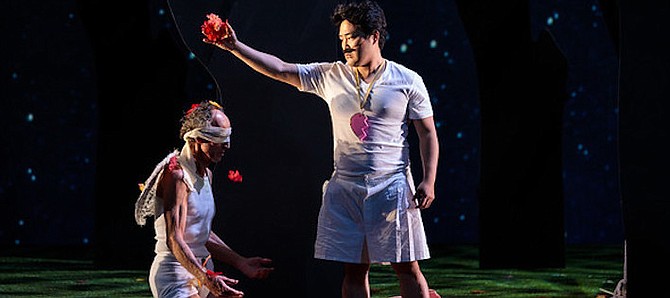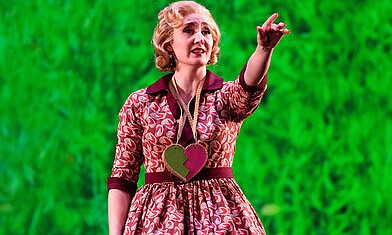 Facebook
Facebook
 X
X
 Instagram
Instagram
 TikTok
TikTok
 Youtube
Youtube

I attended San Diego Opera’s production of Cosi fan Tutte on Saturday, February 12. I was somewhat dismayed at what I saw. The singers were fine. The production was yet another ill-conceived re-imagining of a tried and true opera.
I’ve come to expect those things at an opera production and not just an opera production at San Diego Opera. Even at The Metropolitan Opera, I expect the singers will be fine if not spectacular and the production will be one concept or another that doesn’t stay consistent with itself or the text of the opera. Those things were not dismaying. I saw something new to be dismayed about.
What was dismaying is that it appears that the San Diego Opera is broke. Not broken but broke as in no money. The set was much smaller than the stage of The Civic Theatre. The costuming was minimal, the chorus master was conducting the production — quite well, the chorus was kept off-stage and the audience attendance looked to be sparse.
The smaller set costs less money. The minimal costumes cost less money. Having the chorus master/music administrator conduct removes or at least reduces the conductor’s fee. Keeping the chorus off stage costs less money. There are no chorus staging rehearsals to pay for. There are no chorus costumes to pay for. There are no chorus costume fittings to pay for.

All of the cost savings added up to a production of Cosi fan Tutte that was satisfying from a musical perspective. Chorus Master Bruce Stasyna led the San Diego Symphony and adeptly accompanied the singers with the correct orchestral balance for the vocal abilities of the cast. It must be said that the orchestra could have been better in the overture. The players of the San Diego Symphony fell back into their old habit of static phrasing with Mozart.
Mezzo-soprano Samantha Hankey as Dorabella and tenor Konu Kim as Ferrando stood out from the rest of the cast. Ms. Hankey’s voice was of adequate size for the house and was remarkably consistent in tone and timbre from top to bottom. Mr. Kim’s voice was well-grounded with a developing chest register which gave his upper notes a virility that is often lacking in tenors who sing Mozart.

The production started with a concrete men’s locker room and then moved to a psychological, “Field of Possibilities as the sun sets” and a psychological “Darkening forest of the mind.” Those descriptions were provided by the program. The production then went on to use the psychological settings in very concrete ways.
A production must either be abstract or representational. The practice of mixing the two is unacceptable. For too long, opera productions have been given a free pass for the incongruities they create. Go abstract or go representational. I don’t care which one is used but a production must always follow its own rules and this one did not.


I attended San Diego Opera’s production of Cosi fan Tutte on Saturday, February 12. I was somewhat dismayed at what I saw. The singers were fine. The production was yet another ill-conceived re-imagining of a tried and true opera.
I’ve come to expect those things at an opera production and not just an opera production at San Diego Opera. Even at The Metropolitan Opera, I expect the singers will be fine if not spectacular and the production will be one concept or another that doesn’t stay consistent with itself or the text of the opera. Those things were not dismaying. I saw something new to be dismayed about.
What was dismaying is that it appears that the San Diego Opera is broke. Not broken but broke as in no money. The set was much smaller than the stage of The Civic Theatre. The costuming was minimal, the chorus master was conducting the production — quite well, the chorus was kept off-stage and the audience attendance looked to be sparse.
The smaller set costs less money. The minimal costumes cost less money. Having the chorus master/music administrator conduct removes or at least reduces the conductor’s fee. Keeping the chorus off stage costs less money. There are no chorus staging rehearsals to pay for. There are no chorus costumes to pay for. There are no chorus costume fittings to pay for.

All of the cost savings added up to a production of Cosi fan Tutte that was satisfying from a musical perspective. Chorus Master Bruce Stasyna led the San Diego Symphony and adeptly accompanied the singers with the correct orchestral balance for the vocal abilities of the cast. It must be said that the orchestra could have been better in the overture. The players of the San Diego Symphony fell back into their old habit of static phrasing with Mozart.
Mezzo-soprano Samantha Hankey as Dorabella and tenor Konu Kim as Ferrando stood out from the rest of the cast. Ms. Hankey’s voice was of adequate size for the house and was remarkably consistent in tone and timbre from top to bottom. Mr. Kim’s voice was well-grounded with a developing chest register which gave his upper notes a virility that is often lacking in tenors who sing Mozart.

The production started with a concrete men’s locker room and then moved to a psychological, “Field of Possibilities as the sun sets” and a psychological “Darkening forest of the mind.” Those descriptions were provided by the program. The production then went on to use the psychological settings in very concrete ways.
A production must either be abstract or representational. The practice of mixing the two is unacceptable. For too long, opera productions have been given a free pass for the incongruities they create. Go abstract or go representational. I don’t care which one is used but a production must always follow its own rules and this one did not.
Comments